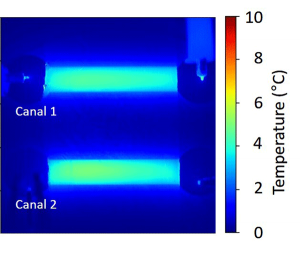Temperature control close to biological interactions
for biosensors
Biodetection based on the principle of surface plasmon resonance is one of the most accurate ways to detect the presence of pathogens in a fluid.
Nevertheless, the temperature of the analyte under test must be very finely controlled in order not to disturb the measurements. The use of the sensor surface as a thermo-regulating element allows this control while simplifying its implementation, a decisive step towards the portability of detection systems …
Biodetection based on the principle of surface plasmon resonance (SPR) is a very sensitive biodetection technique currently reserved for analytical laboratories. It is a technique without labeling of the target cells (« label free ») contained in the analyte and whose detection specificity is linked to that of the probe cells grafted on the sensor. Its measurement principle involves only physical laws, in this case the technique measures very precisely the optical index of any material or fluid that is in the very close vicinity (a few hundred nanometers) of the sensor surface. This last one is realized by a metallic film of nanometric thickness (a few tens of nanometers).
Whether it is the molecular interaction involved or the optical index of the solution under test, both are extremely dependent on the temperature at which the measurement is made. For this reason, a temperature control is necessary and it complicates the implementation of the system, depriving it of the portability of the measuring equipment.
Within the framework of the cross-border INTERREG V France-Walloon Flanders project BIOSENS aiming at developing a portable equipment for the detection of phyto-pathogens in the field, the thin metallic layer of the SPR sensor has been used as a thermo-regulating element. The injection of a current in this metallic film allows to regulate very finely the temperature and this as close as possible to the biomolecular interaction.
« Plasmonic layer as localized temperature control element for surface plasmonic resonance based sensors », S. Ganesan, S. Maricot, J-F. Robillard, E. Okada, M-T. Bakouche, L. Hay, J-P. Vilcot, Sensors, 21(6), 2035, https://doi.org/10.3390/s21062035
Contact :














